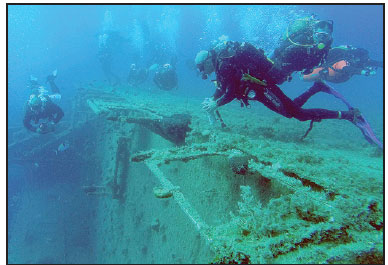'Titanic of the Med' wreck lures thousands of divers to Cyprus
An iron and steel colossus that sank on a summer's night 35 years ago off Cyprus is now considered one of the world's best shipwreck dives.
Thousands dive down each year to see the Zenobia-the "Titanic of the Mediterranean" - which is slumped on its port side at a depth of 40 metres (130 feet) off the island.
The roll-on, roll-off Swedish ferry, named after a third-century queen of ancient Palmyra, is the top wreck dive in Europe, competing with sites in the Red Sea, Asia and off Australia.
"It's so big you can dive a few days and not get bored," said Mat Howell, who works for a British-based scuba diving holiday firm and was in Cyprus for the annual "Zenobia Week" at the end of June to promote the site.
Unlike many other wrecks, the Zenobia is easily accessible, only a 10-minute boat ride from the coastal resort of Larnaca.
Like the Titanic which sank in the Atlantic in 1912, the Zenobia came to grief on its maiden journey on its way to the Syrian port of Tartus.
On June 2, 1980, shortly after midnight, the captain of the listing vessel sent out an SOS.
Trawlers went to the rescue from Cyprus but to no avail and the Zenobia went down five days later, without loss of life but with around 100 articulated lorries loaded with cigarettes, cables and one million eggs still on board.
Theories for the cause of the disaster range from navigation errors, ballast problems and an insurance scam to sabotage because of an alleged secret consignment of arms.
'The wreck is treacherous'
Over three decades later, divers zig-zag between the sunken trucks, rusty but still intact, while the more experienced enter the dark caverns of the sleeping hulk or the upper car deck and accommodation area, some even making it to the engine room.
"You can still see the carpeting of the upper deck and even the tables in the restaurant area," said diving instructor Hatte Clasen of the wreck, which extends over 172 metres of seabed.
Although no one died when Zenobia sank, the wreck has since claimed the lives of several scuba divers.
"The wreck is treacherous: some divers take risks and lose themselves in rooms in which they should not enter," Clasen said.
Entering wrecks carries greater risk because of the danger of entanglement or getting trapped, as well as the extra time needed to reach the surface in the event of a problem.
Additional training, experience and equipment is often recommended, particularly when penetrating deep inside a wreck.
Luckily for less experienced divers there is plenty to see from the outside of the Zenobia, which has also become a magnet for marine life, an aquarium of brown groupers and barracudas.
Andrei Pligin, a 16-year-old enthusiast, re-surfaces from what was his 206th dive to rave about his latest experience.
"The weather is good. You don't have any currents. So you just get pleasure going all around the ship," said the young blue-eyed Russian, an annual visitor to the Mediterranean's third-largest island.
The site alone attracts 45,000 visitors each year, according to local authorities.
They have been campaigning for the government to impose a fishing ban around the Zenobia to preserve what has turned into the biggest coral reef off Cyprus.
Diving enthusiasts stress the tourism potential, lauding the destination as a rival to popular destinations including Egypt's Red Sea.
Jonathan Wilson, who runs a diving firm in Limassol, another Cypriot resort on the south coast, estimated the Zenobia brings in 14 million euros ($15 million) a year.
Sheltered from the chaos and insecurity of Arab countries across the water, recession-hit Cyprus relies heavily on revenues from tourism, a sector which accounts for around 12 percent of GDP.
With recovery on the horizon following a 2013 bailout of its banks, Cyprus says arrivals for the first six months of this year passed the one million mark for the first time in a decade.
|
Divers swim near the Zenobia shipwreck, a Swedish built ferry that capsized and sank off the coast of the Cypriot port city of Larnaca in 1979 during a 'Mass Dive' event in which over 120 divers participated, on June 28, 2015. Emily IrvingswifT / AFP |



















